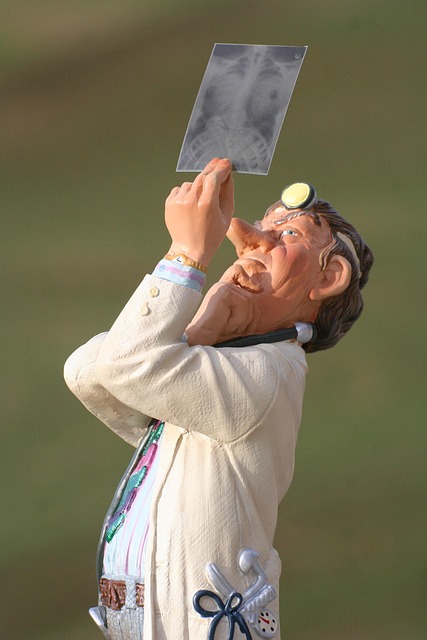Contrast-enhanced radiography (CER) leverages contrast media, like iodinated agents, to visualize blood vessels in angiographic procedures. Ionic compounds enhance X-ray absorption for high-resolution imaging, while non-ionic agents improve contrast in slow-flow conditions. CER aids in diagnosing and monitoring vascular issues, such as blockages and aneurysms, providing real-time feedback during treatments. However, risks include allergic reactions and temporary kidney damage; safe practices require careful patient selection and monitoring. Future prospects involve safer contrast agents and advanced computer-aided detection systems to enhance diagnostic speed, accuracy, and patient safety in CER.
Contrast media play a pivotal role in angiography and blood vessel imaging, enhancing visibility for accurate diagnosis. This article explores the intricacies of contrast-enhanced radiography (CER), delving into the types and functions of these agents. We’ll navigate the process of CER, its diverse applications, and the associated benefits and risks. Additionally, we’ll gaze towards future perspectives, highlighting how advancements in contrast media are revolutionizing angiographic techniques.
Understanding Contrast Media: Types and Functions
Contrast media play a pivotal role in enhancing the visibility and clarity of blood vessels during angiographic procedures. These substances are carefully selected based on their unique properties to serve various functions in contrast-enhanced radiography. There are two primary types: ionic and non-ionic agents. Ionic contrast media, such as iodinated compounds, have a direct effect on X-ray absorption, making blood vessels more prominent on the images. They are commonly used in procedures like computed tomography (CT) angiography due to their high contrast resolution.
Non-ionic contrast media, on the other hand, exhibit a slower clearance from the body and can improve the contrast between vessels and surrounding tissues. This type is particularly beneficial for studies focusing on slow-flow conditions or when a longer vascular phase is required. By optimizing these properties, healthcare professionals can achieve detailed blood vessel imaging, facilitating accurate diagnosis and treatment planning in various medical conditions.
The Process of Contrast-Enhanced Radiography
Contrast-enhanced radiography is a powerful tool in angiography and blood vessel imaging. The process involves administering a contrast medium, typically an ionic compound, into a patient’s bloodstream. This medium is designed to be dense and highly attenuating, allowing it to outline and highlight the structures of interest, such as arteries, veins, and capillaries, when imaged with X-rays.
The contrast medium circulates through the body, reaching all vascular spaces. As it passes through these areas, it absorbs X-ray radiation differently compared to surrounding tissues, creating a distinct contrast between the vessels and the background. This enhanced visibility enables radiologists to accurately assess blood flow, detect anomalies like blockages or leaks, and gain valuable insights into various vascular conditions.
Applications in Angiography and Blood Vessel Imaging
Contrast media play a pivotal role in angiography and blood vessel imaging, enhancing visibility and providing critical information about vascular structures. By injecting these substances into the bloodstream, healthcare professionals can capture detailed images of arteries, veins, and capillaries using various imaging techniques, such as X-ray radiography or magnetic resonance imaging (MRI). This enables precise diagnosis of conditions like aortic aneurysms, stenoses, and thrombosis, where the contrast between the vessel walls and the surrounding tissue becomes essential for accurate detection.
Contrast-enhanced radiography, in particular, relies on these media to highlight blood vessels and facilitate their visualization. The differing densities of the contrast agent and nearby tissues create distinct contrasts, making it easier to identify abnormalities or blockages within the vasculature. This application has proven invaluable in interventional procedures, allowing for real-time monitoring and guidance during treatments like angioplasty or stent placement.
Benefits, Risks, and Future Perspectives
Benefits
Contrast-enhanced radiography, facilitated by the use of contrast media, significantly enhances the quality and diagnostic value of angiographic images. These media agents, when injected into the bloodstream, selectively outline blood vessels, enabling clear visualization of their structure, size, and any abnormalities. This technique is invaluable in diagnosing conditions such as blockages, aneurysms, and vascular malformations that might otherwise remain undetected on standard X-rays. Moreover, it aids in evaluating the efficacy of treatments like stent placements or angioplasties by providing real-time feedback on blood flow dynamics.
Risks
Despite its benefits, contrast-enhanced radiography is not without risks. The most common adverse reactions are related to the injectable contrast media, including allergic responses ranging from mild skin rashes to severe anaphylaxis. Additionally, these agents can cause temporary kidney damage, particularly in patients with pre-existing renal issues. Radiation exposure during the procedure also poses a risk, especially with repeated procedures over time. Therefore, careful patient selection, informed consent, and appropriate monitoring are essential to ensure safe contrast-enhanced radiography.
Future Perspectives
The future of contrast media in angiography looks promising with ongoing research into safer and more effective formulations. Biodegradable and ion-free contrast agents are being developed to minimize potential side effects. Furthermore, advancements in computer-aided detection (CAD) systems integrate contrast-enhanced images with advanced algorithms to automatically highlight and analyze vascular abnormalities, potentially improving diagnostic speed and accuracy. As technology evolves, contrast-enhanced radiography is poised to remain a cornerstone of blood vessel imaging while continuously refining patient safety and outcome measures.
Contrast media play a pivotal role in modern angiography and blood vessel imaging, enhancing the clarity and detail of diagnostic visualizations. Through their unique properties, these substances enable more precise identification of vascular abnormalities. As technology advances, ongoing research into safer and more effective contrast agents will further revolutionize contrast-enhanced radiography, leading to improved patient outcomes and enhanced understanding of the circulatory system.
